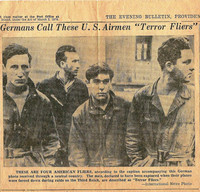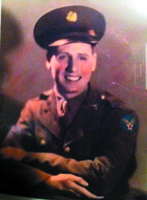By ETHAN HARTLEY Almost 75 years ago to the day, Staff Sergeant Raymond W. Barnes took off around 8 a.m. as part of a 10-man crew in his designated B-17 Flying Fortress to lead an aerial force of 500 other planes for a bombing run targeting submarines in
This item is available in full to subscribers.
We have recently launched a new and improved website. To continue reading, you will need to either log into your subscriber account, or purchase a new subscription.
If you are a current print subscriber, you can set up a free website account by clicking here.
Otherwise, click here to view your options for subscribing.
Please log in to continue |
|


Almost 75 years ago to the day, Staff Sergeant Raymond W. Barnes took off around 8 a.m. as part of a 10-man crew in his designated B-17 Flying Fortress to lead an aerial force of 500 other planes for a bombing run targeting submarines in Bremen, Germany with the 8th Army Air Force.
By the end of the day his plane would be shot down, seven of his comrades would be dead and he would be a prisoner to the German army, with whom he would remain for 18 months.
Barnes’ harrowing story would not perhaps ever have become known if not for the historical detective work of his son, Ron, who utilized all the best aspects and capabilities of the internet and social media in order to track down people who were familiar with the event in order to learn more about it – which ultimately led to an amazing connection with a German man who wrote a book about the incident after seeing it happen firsthand when he was just a child.
“My father never spoke about this, ever,” said Ron, whom you may know as the current Commander of the Pawtuxet Rangers, during a recent interview. “Never talked about being shot down. He was proud of his service but he never talked about this, and my mother didn't want him to.”
The lack of knowledge extended so far that Ron didn’t even know the name of his father’s B-17. His journey started as a way to identify the plane, and turned into something much more significant.
Ron had a grainy photo of his father and the crew of 10 posed in front of their bomber, but no name was visible. Only a series of identification numbers were slightly visible in the photograph, so Ron took to the Internet back in 2011 to an Army Air Force message board to post the photo and see if anybody else could help identify the plane or had any more information.
He struck pay dirt when someone was able to not only identify the bomber, but also find a missing aircrew report that documented the plane being shot down, along with identifying the 10 members of the crew – including his dad. Incredibly, the report also contained a written testimony from Raymond Barnes himself, which had a firsthand, written account of exactly what happened on that day, Nov. 26, 1943.
Barnes’ report details how once the B-17 got over the English Channel they lost one motor to engine failure. Over France, a second motor failed. This led to the bomber falling behind the squadron to be singled out by German attacking aircraft. Barnes’ description of what happened next is best told in his own words.
“The gas tank on the right side was hit and burning gasoline was spraying back into the bomb bay. The ball turret gunner was hit and came up into the radio room and lay on the floor. Then one of the waist gunners was hit. In a few minutes a shell landed in my radio and blew it up in my face. When the shell exploded in the radio room it shattered the oxygen lines. We were at 29,000 feet and you know the air is so thin up there that you couldn’t breathe. I called the pilot on the interphone and told him that I was going to bail out and one of the waist gunners told him the same. I jumped through the open bomb bay, which the bombardier had opened to get rid of the bombs.”
Barnes jumped from the plane and pulled his chute, but the low oxygen and intense situation likely caused his blood pressure to spike and made him lose consciousness.
“When I came to, I was floating through the air and my parachute was open,” his account continues. “A German fighter plane was circling around me.” Barnes hypothesized the fighter was calling in his coordinates to ground troops to make sure they knew where he would be landing, which turned out to be in the field of a farm in a village outside of Bremen.
“German men and women came running toward me and the men had shotguns. I thought it was the end but they didn’t shoot,” Barnes’ writing continues. “They took me into a farmhouse and kept me there ‘til after dark. I landed there around noon. That afternoon all the people in the village came in to see what I looked like. After dark the German soldiers came for me and took me to an army post. There they locked me up in a cell for the night.”
German soldiers then took him to a hospital in Bremen where he was treated for the injury to his eye, which was completely lost as a result. He describes how the Germans took his warm flight boots and he never saw them again. He was taken to another hospital before being transferred to a prison camp in East Prussia, which also housed British POWs.
Barnes would remain in the camp until the allies won the war and the camp was liberated. He described General Eisenhower visiting the camp and telling them they had first priority to be flown home. While it took longer than expected – and Barnes described some men committing suicide being unable to wait any longer – he was eventually boarded onto a troop ship and sent home.
Unexpectedly, through researching his father’s story, Ron Barnes stumbled upon the lifelong quest of a German man, Hinrich Barning, who after watching the B-17 crash and explode in his little farm village and seeing Raymond Barnes be captured spent the remainder of his life trying to find out the fates of the men aboard who survived the crash.
Barning wrote a book in German, “Leidvoll! To Suffer!” which directly mentioned Ron’s father being captured.
“Staff Sergeant Raymond Barnes was very unlucky and landed quite a distance away. One of the farmers who lived nearby helped him into the farmhouse. The old man gave Barnes a cup of hot coffee to drink and then made a call on the fire warning telephone so a team could be sent to pick up the prisoner-of-war,” the book describes. “The staff sergeant still had the bar of chocolate left from his survival rations and gave it to the old man, who ate it with great delight. Staff Sergeant Barnes then showed the old man a picture of his mother and wondered how she’d be informed that he hadn’t been killed but instead was now a POW.”
Nathan Giles, helping Barning with the English translation to the book, had just so happened to make a post asking for more information about the same crash incident five years prior to Ron Barnes making his own post with the same mission in mind – albeit for different reasons.
Barnes and Giles connected, and started sharing all the information they had gathered. The knowledge that three of the men had survived the ordeal and lived beyond the war was a great relief to Barning, who has since passed away.
“Hinrick told me that locating the three men who jumped from the B-17 were part of the healing process he was going through. The feeling of not knowing their fate was very uncomfortable for him. He needed to know what happened to them and fervently hoped that they had survived the war,” said Giles in correspondence with Ron. “He said that if they had returned to America and had families and children of their own then at least some good had come out of the horrors of the war.”
Amidst his research was many other smaller, interesting finds. Such as a picture he came across from the Providence Evening Bulletin published in their Jan. 20, 1944 edition that showed four captured U.S. Army Airmen and described how the Germans released the photos to show they had captured four “terror fliers,” as they called them.
Little did the Providence paper know that the soldier on the far left with the bruised face was native Rhode Islander Raymond Barnes. Following the war, Barnes would go on to spend 36 years in the Cranston school system as a custodian.
With an entirely different mystery pieced together that he never originally intended on solving, Barnes still hadn’t solved the mystery that set him on his mission in the first place – the name of the B-17 that his father was shot down in. Turns out, he didn’t need to go further than his own family for the information. Ron’s nephew had apparently been told the name by his grandfather – the Melancholy Baby.
“It was unbelievable to find something like this,” Ron said of the whole experience.
Comments
No comments on this item Please log in to comment by clicking here